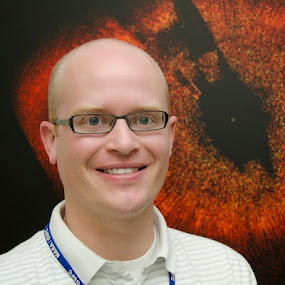Staff Postdocs Students Alumni
STScI Staff

Christine Chen (she/her): I am deeply interested in understanding the late stages of planetary system formation and evolution to determine whether planetary systems like our own are common or rare. I use multi-wavelength observations to constrain the composition and location of dust and therefore the history of exo-planetary systems. Website: https://www.stsci.edu/~cchen/STScI/index.html
John Debes (he/him): John Debes is interested in planetary systems across all phases of stellar evolution. In particular, he studies cold debris disks, exo-zodi systems, and planetary systems around post-main sequence stars. Website: https://www.stsci.edu/~debes/
Julien Girard (he/him): Dr Julien Girard has over 20 years of experience in optical/infrared astronomy, either building, commissioning, operating, or using instruments with high contrast capabilities. JWST/NIRCam and Roman Instrument Scientist, Girard led the successful on-sky commissioning of the NIRCam Coronagraphy mode. Girard's research focuses on the demographics and characterization of long-period giant extra-solar planets and brown dwarfs in their circumstellar environments. Before STScI, Girard was a Staff Astronomer and Adaptive Optics specialist at the Paranal Observatory for 8 years, Lead Instrument Scientist of VLT/SPHERE & NACO. He spent nearly a thousand nights in the Atacama desert! Earlier in his career, Girard also worked in Mexico City as a Postdoctoral Fellow and Assistant Professor. Girard obtained his PhD in 2005 in Lyon working on the polychromatic laser guide star concept. Website: https://www.juliengirard.space
STScI AURA Observatory Scientist
JWST/MIRI Instrument & Science Teams
HST/ACS Instrument Team. Interests, expertise: Extragalactic: Active Galactic Nuclei, QSOs and QSO Host Galaxies. Galactic: Formation & Evolution of Planetary Systems, Pre-Planetary Nebulae, Supernovae Remnants. General Astrophysics: Astrophysical Dust. Instrumentation: Visible & Infrared Imaging & Spectroscopy, Visible & Infrared Spectro- & Imaging Polarimetry. Website: www.stsci.edu/~hines
Elena Manjavacas (she/her): I graduated in 2010 in Physics from the Universidad Complutense de Madrid (Spain). In 2011, I obtained a master in Astrophysics from the Universidad Complutense and Autonoma de Madrid (Spain). I did my PhD thesis at the Max Planck Institute for Astronomy (Heidelberg, Germany) between 2011 and 2015, in the field of Low-mass stars, Brown Dwarfs and Exoplanets. In 2015, I moved for my first postdoc to the Instituto de Astrofisica de Canarias (IAC), in Spain, where I worked on the commissioning of EMIR, a near-infrared multi-object spectrograph installed at the 10-m GTC telescope in La Palma (Spain). In 2016, I moved to Tucson (Arizona, USA), to start my second postdoc at the Steward Observatory (University of Arizona), where I continued my research on the flux variability of brown dwarfs and planetary-mass objects, using the WFC3 instrument at Hubble Space Telescope. From January 2019 until October 2020, I was a Staff Astronomer at W. M. Keck Observatory, in Hawaii. Now, I am a ESA/AURA Astronomer for the NIRSpec instrument onboard the JWST telescope at the Space Telescope Science Institute (Baltimore, USA).

Colin Norman: Generally I work on astrophysics. For exoplanets, I am now specifically focussed on the physics of advanced optics systems for imaging exoplanets and the classic problem of the formation of planetesimals. I also co-direct the JHU Institute for Planets and Life with Jocelyne DiRuggiero.
Marshall Perrin: I develop and employ advanced instrumentation for imaging planets and disks around other stars, in particular making extensive use of infrared integral field spectroscopy and imaging polarimetry. I have been a part of the Gemini Planet Imager team since the project's inception over a decade ago, and these days I co-lead GPI's Data Analysis & Data Pipeline team. I carry out observations of nearby circumstellar disks using HST, GPI, and other facilities, and collaborate in the development of our lab testbeds for high contrast and wavefront control.
Laurent Pueyo:
Neill Reid: I have a long-term interest in low-mass stars and brown dwarfs that have morphed into curiosity about the frequency of planets and their formation processes. Most of the time I’m buried in other activities, but occasionally I still manage to get the occasional moment for research in those areas.
Emily Rickman (she/her): Dr. Emily Rickman is a Science Operations Scientist for the European Space Agency (ESA) at the Space Telescope Science Institute. Her research focuses on combining astrometric and radial velocity data to find promising candidates to directly detect with high-contrast imaging, and characterize detections both atmospherically via integral field spectroscopy and dynamically via orbit fitting. Dr. Rickman seeks to investigate exoplanetary systems with HST and JWST with collaborators as part of STScI's Extrasolar Planetary Systems Imaging Group (EPSIG). She has led a number of programs with ground-based observatories with high-contrast imaging using VLT/SPHERE, as well as interferometry with VLTI/GRAVITY. Dr. Rickman is a member of the HST team providing support to the STIS instrument. She is also a project-level member of the JWST Telescope Scientist Team for coronagraphy, as well as the JWST High-Contrast Imaging ERS Team. Website: https://www.emilyrickman.com/ 
Anand Sivaramakrishnan: I helped to create the first three extreme adaptive optics coronagraph projects ever: The Lyot Project, Project 1640, and the Gemini Planet Imager. My early work with Russ Makidon derived these instruments' basic parameters. My theoretical work demonstrated the need for extreme adaptive optics for direct imaging of exoplanets using ground-based telescopes. Using the American Museum of Natural History and Brookhaven National Laboratory facilities, I steered the development of today's most widely-used coronagraphic masks. Nowadays I lead the interferometric imaging component of the James Webb Space Telescope, which will fly a non-redundant aperture mask. I try to combine wavefront sensing with scientific imaging. I teach a graduate class in Fourier Optics at JHU.

Remi Soummer: I develop novel coronagraph designs, speckle statistics theories, and innovative high-fidelity modeling algorithms for high-contrast imaging. I have been the coronagraph architect of the Gemini Planet Imager and Palomar Project 1640, as well as being involved in star shades research and development of other future space missions concepts. I am currently a member of the NASA Exoplanetary Program Advisory Group (ExoPAG) Executive Committee. And I am the head of the Russell B. Makidon Optics Lab at STScI.
Postdocs
Kielan Hoch (she/her): I am interested in how our solar system came to be by studying the formation of widely separated gas giant planets. I use direct imaging spectroscopy to measure elemental abundances in the atmospheres of these companions to trace where and how they may have formed. To do this, I use intergral field spectrographs such as OSIRIS on Keck and NIRSpec on JWST.
Mathilde Mâlin (she/her): Mathilde Mâlin is a postdoctoral research assistant from JHU/STScI. She is working on high-contrast imaging of exosystems with JWST, and in particular at mid-infrared wavelengths with MIRI. She graduated from Sorbonne University/Paris Observatory in 2023, where she worked on MIRI/MRS simulations to characterize the atmosphere of young giant planets. She is also working on the first exoplanetary systems imaged with MIRI coronagraphs.

Emiel Por (he/him): My research focuses on advanced instrumentation for the direct imaging of exoplanets for both ground- and space-based telescopes. During my PhD at Leiden Observatory, I led the development of HCIPy, a widely used optical propagation library for simulating coronagraphs and adaptive optics systems. Segmented primary mirrors require that all segments stay aligned during a coronagraphic observation. Therefore, besides a high-performance coronagraph, high-order wavefront sensing and control will be required for the Habitable Worlds Observatory, the future NASA flagship mission. As an NHFP Sagan fellow at STScI since January 2021, I have been working on developing novel coronagraph solutions that jointly optimize both contrast and wavefront sensing and control performance. Website: https://ehpor.github.io/

Sarah Steiger (she/her): I got my B.S. in Physics from Boston College in 2017 before moving to UC Santa Barbara where I got my Ph.D. in 2023. There I worked with Dr. Ben Mazin on high-contrast imaging with the MKID Exoplanet Camera (MEC) and developing the MKID Data Reduction and Analysis Pipeline. I started at STScI as a Postdoctoral Fellow in the Community Missions Office in Summer 2023 and am excited to work on developing technologies for future missions such as the Habitable Worlds Observatory along with the Makidon Optics Lab. Besides instrumentation, my science interests lie in high-contrast imaging more generally including exoplanets, brown dwarfs, and disks as well as combining multiple detection techniques to better characterize systems.
Grad Students
William Balmer (they/them): I work on using optical interferometry from the ground, and coronagraphy from space, to observe planets and substellar objects along the bleeding edge of detect-ability and atmospheric recovery (very close objects from the ground, and very faint objects from space). I also work on observationally benchmarking atmospheric models, spectral retrievals, and on accretion and formation. Website: wbalmer.github.io Carl Ingebretsen (he/him): I am a first year graduate student at JHU working on observations of debris disks with JWST NIRSpec.My interests are in the study of debris disk morhphology, composition, dynamics and planet-disk interactions.
Natalia Oliveros-Gomez (she/her): Study of cloud structures in brown dwarf atmospheres and their variability. Using observational data from telescopes such as HST and JWST and modeling their spectra theoretically. Also, I do outreach astronomy, mainly in Spanish and mainly associated with Colombia. Website:https://onatalialucia.wixsite.com/astronomia?lang=en
Kadin Worthen (he/him): I am interested in the formation and evolution of planetary systems. I study gas, dust, and planets in young debris disk systems through multi-wavelength observations to understand the processes that shape planetary systems.
Research & Instrumentation Analysts/Scientists
Jonathan Aguilar (he/him): I am the JWST/MIRI Coronagraphic Imaging Mode support lead. My research focuses on the demographics of companions along the brown dwarf/planet boundary.
Richard Cosentino (he/him): My aspirations started in engineering and evolved towards astronomy and NASA missions. Being a part of the OSIRIS-REx mission and now the Nancy Grace Roman Space Telescope has allowed me to explore opportunities within planetary science that is well beyond and significantly different from my PhD research on Jupiter's atmospheric jets, waves, and turbulence. Website: https://www.linkedin.com/in/richard-cosentino-5586a2153/
External Collaborators
ESO Fellow, Garching, Germany
Planet formation & evolution, direct imaging of substellar companions and circumstellar disks, planet & brown dwarf atmospheres, extreme angular resolution imaging using long-baseline interferometry with the VLTI and sparse aperture masking with SPHERE & JWST, exoplanet yield modeling, detection & characterization of Earth-like exoplanets with future telescopes.
Isabel Rebollido (she/her)
ESA Research Fellow, ESAC, Madrid, Spain
I am interested in planet formation and the early stages of planetary systems. I use both ground and space-based spectroscopic and high-contrast imaging observations to investigate disks and the minor bodies in them (i.e. comets, asteroids, moons) and how they are able to shape the chemistry and architecture of planetary systems. Website: https://isabelrebollido.com/
Chris Stark
NASA Goddard, Greenbelt, MD, USA
I am interested in understanding the architecture of mature planetary systems, primarily how disks and planets interact. This has led me to theoretical studies of disk-planet dynamics, novel observational searches for planet-induced disk structures, and observational constraints on the optical properties and composition of debris disk dust grains. I’m also intensely interested in the search for Earth-like exoplanets and am working to understand the requirements for a future ExoEarth-characterizing mission.
Assistant Professor, Smith College, MA, USA
I work on high contrast imaging and multi-wavelength observations of low-mass stars, brown dwarfs, exoplanets, and their environments. I am actively working on companion and circum(sub)stellar disk characterization, as well as coronagraphy techniques and post-processing from space (with HST/STIS and JWST/MIRI) and from the ground (with the Gemini Planet Imager). Website: http://kward-duong.space/
Former Group Members - see our Alumni page.


























Comments
Post a Comment